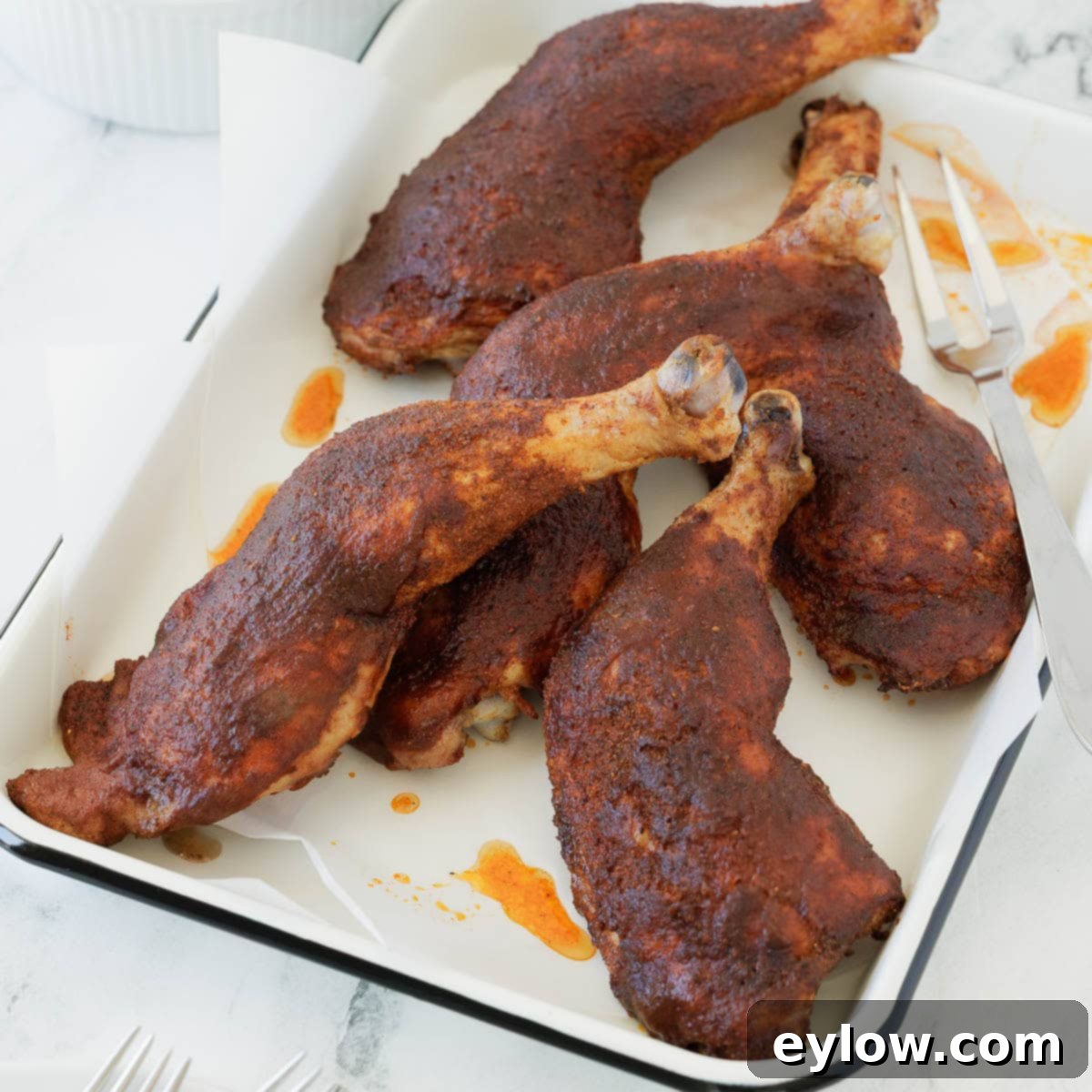Perfectly Smoked Chicken Legs: Juicy, Tender, and Full of Flavor
If you’ve primarily focused on smoking chicken drumsticks, it’s time to elevate your game with the full leg-thigh combo. These smoked chicken legs, crafted from whole chicken legs or convenient leg quarters, offer a significantly meatier bite, richer flavor, and an incredibly satisfying experience that’s just as simple to achieve. Infused with a delicate smoky essence and boasting supremely tender, juicy meat, they present an effortless yet impressive way to upgrade your outdoor cooking repertoire, especially during the warmer months. You can choose to finish them with a sweet and savory BBQ glaze for extra shine and flavor, or serve them as they are, letting the natural smoky notes shine through. Don’t forget to save any delicious leftovers – they make for truly amazing tacos, salads, or wraps the next day!

For this foolproof recipe, I rely on my tried-and-true all-purpose dry rub, which perfectly seasons the chicken before it hits the smoker. If you desire a beautiful, caramelized finish and an extra layer of flavor, a quick glaze of BBQ sauce towards the end of the cooking process works wonders. This method is incredibly budget-friendly, making it an excellent choice for family meals or entertaining. It’s also perfectly suited for outdoor cooking on a pellet grill or traditional smoker, ensuring rich, tender, and consistently delicious results every time thanks to the low and slow smoking process. These smoked chicken legs have quickly become our go-to summer favorite, and we’re sure they’ll be yours too.
[feast_advanced_jump_to]
Why These Smoked Chicken Legs Will Become Your New Favorite
These smoked chicken legs aren’t just a meal; they’re an experience. Here’s why they stand out and why you’ll find yourself making them again and again:
- Budget-Friendly Protein – Whole leg quarters are an incredibly economical choice, offering substantial, flavorful dark meat without breaking the bank. They provide excellent value, allowing you to feed a crowd or enjoy delicious meals throughout the week without sacrificing quality or taste.
- Big Flavor, Easy Method – You don’t need to be a pitmaster to achieve extraordinary results. A simple, well-balanced dry rub combined with the magic of a smoker delivers deep, smoky flavors and incredibly juicy chicken. Minimal prep leads to maximum taste, making this a perfect recipe for both novice and experienced grillers.
- Versatile Cooking Options – Whether you own a dedicated pellet grill, a traditional offset smoker, or even a gas grill set up for indirect heat with a smoker box or a smoke tube, this recipe adapts beautifully. The key is maintaining consistent low heat and introducing wood smoke, which can be achieved through various setups.
- Fantastic Leftovers for Creative Meals – Don’t underestimate the power of smoked chicken leftovers! The smoky, tender meat shreds beautifully, making it perfect for quick and easy tacos, vibrant salads, satisfying wraps, or even a flavorful addition to pasta dishes the next day. Cooking extra is always a good idea.
- Superior to Drumsticks Alone – While drumsticks are great, the whole leg quarter (thigh and drumstick together) offers a richer, more complex flavor profile and significantly more meat. The combination of different textures from the thigh and drumstick, along with the extra fat from the thigh, keeps the chicken exceptionally moist and flavorful throughout the smoking process, surpassing the experience of just drumsticks.
Looking for a fantastic accompaniment? A terrific side dish for these savory smoked chicken legs is a sweet corn succotash, especially one enhanced with crispy bacon. Its fresh flavors and contrasting textures perfectly complement the smoky chicken.
Essential Ingredients for Perfect Smoked Chicken Legs
Achieving perfectly smoked chicken legs starts with a few high-quality ingredients and the right tools. I primarily use a pellet grill for this recipe—often referred to as a pellet smoker—because it provides consistent, even heat distribution and infuses the chicken with a wonderful smoky flavor, all with minimal fuss and hands-on effort. This allows you to focus on other aspects of your meal or simply enjoy the process.
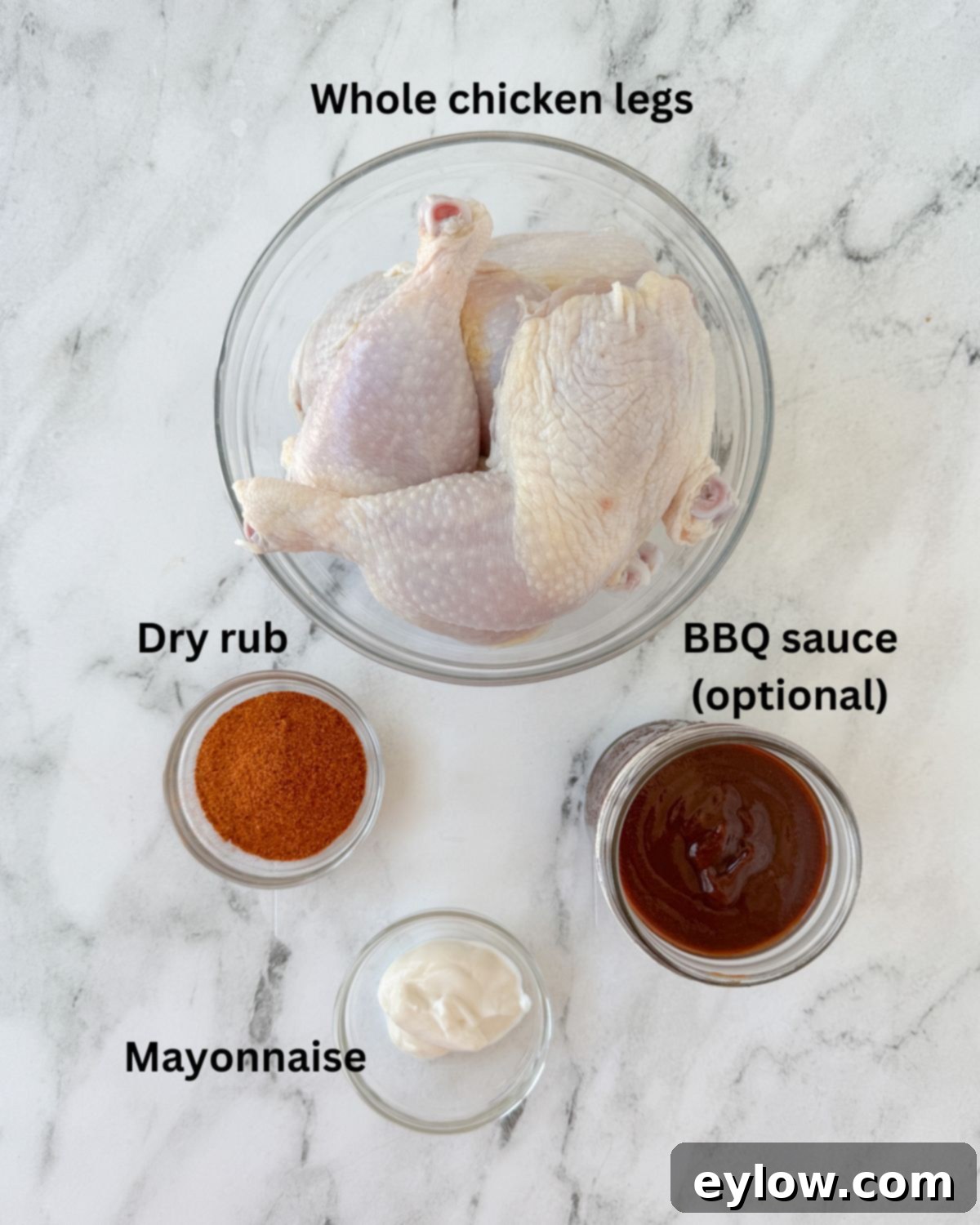
- Chicken – For the most robust, meaty, and flavorful results, I highly recommend using whole chicken leg quarters. These are essentially the thigh and drumstick still attached, offering a fantastic balance of succulent dark meat and skin. You can also find them labeled as chicken quarters. If leg quarters aren’t available, or if you simply prefer them, individual chicken legs or drumsticks work well, though they may cook a bit faster due to their smaller size. Dark meat chicken, with its higher fat content, is inherently forgiving and becomes incredibly tender and juicy when smoked, making it the ideal choice for this slow-cooking method.
- BBQ Rub – The secret to truly standout smoked chicken lies in a great dry rub. I rely on my versatile homemade BBQ dry rub, which is carefully balanced with smoky spices and just a hint of brown sugar for a touch of sweetness. Critically, it’s not overly sweet, preventing your smoked chicken legs from tasting like candy and ensuring a savory, complex flavor profile that perfectly complements the smoky notes. A good rub also contributes to the beautiful “bark” that forms on the chicken’s surface.
- Binder – A thin, even layer of mayonnaise proves to be an excellent binder for smoked chicken. It not only helps your dry rub adhere uniformly to the chicken’s skin, ensuring every bite is seasoned to perfection, but it also withstands the long, slow smoking process without drying out. The fat in the mayo helps to keep the skin moist and promotes browning, creating a desirable crust. Once cooked, you won’t taste the mayonnaise itself, only the incredible flavor of the chicken and rub. Give it a try; you might find it superior to traditional binders like olive oil or vegetable oil.
- BBQ Sauce – While entirely optional, a good BBQ sauce can provide a delicious glaze and enhance the color of your smoked chicken legs. You can use your favorite store-bought brand, or for an even more personalized touch, try my homemade sauce. For easier application and a thinner, more even glaze, consider thinning the sauce slightly with a liquid such as apple juice, pineapple juice, or orange juice. Apple cider vinegar can add a tangy kick, water works in a pinch, or a splash of bourbon can introduce an amazing depth of flavor, especially for a more sophisticated BBQ experience.
For precise measurements of all ingredients, including specific recommendations for salt and pepper, please refer to the detailed recipe card at the end of this article. Remember, a flavorful meal often starts with thoughtful seasoning!
If you’re a passionate smoker of foods, you absolutely must try these 3-2-1 baby back ribs—they are truly fantastic and another excellent way to utilize your smoker.
Chef’s Tip on Pellets and Wood Selection: Choosing the right wood pellets is crucial for imparting distinct smoky flavors. For chicken, I personally favor either 100% pecan shell pellets, which offer a sweet, nutty, and slightly stronger smoke flavor, or a high-quality pure hardwood blend. These blends typically include a mix of hickory (strong, classic BBQ flavor), cherry wood (mild, fruity, great color), maple (sweet, subtle), and apple wood (mild, sweet, fruity, excellent for poultry). Always opt for pellets with no fillers—just pure, clean wood flavor—to ensure the best taste and aroma for your smoked chicken legs. The wood type you choose can significantly influence the final flavor profile.
Creative Substitutions and Flavorful Variations
This smoked chicken leg recipe is wonderfully adaptable, allowing you to tailor it to your preferences or available ingredients. Here are some ideas to spark your culinary creativity:
- Drumsticks in Place of Whole Legs – If whole leg quarters are not readily available at your local grocery store, or if you simply prefer a smaller, more individual portion, chicken drumsticks are a perfect substitute. Keep in mind that drumsticks, being smaller, will cook faster than leg quarters. It’s essential to monitor their internal temperature closely with a reliable meat thermometer to prevent overcooking and ensure they remain juicy. Adjust your cooking time accordingly, likely reducing it by 15-30 minutes depending on size and smoker temperature.
- Experiment with Different Dry Rubs – The world of spice rubs is vast and exciting! Feel free to use your favorite store-bought or homemade spice rub. Whether you lean towards sweet, spicy, or intensely smoky blends, most will complement chicken beautifully. A dedicated poultry rub, especially one featuring aromatic herbs like thyme, sage, or rosemary, could offer a delightful departure from the traditional BBQ profile. While I typically prefer a bold, smoky spice rub for this recipe, a more herb-forward poultry rub could provide a fresh and intriguing variation if you’re looking to explore different flavor dimensions.
- Change Up the Glaze – While BBQ sauce is a classic choice, don’t hesitate to get creative with your glaze. For an Asian-inspired twist, swap the barbecue sauce for a thinned hoisin sauce. You could also try a simple honey-mustard glaze, a spicy buffalo sauce, or even a tangy balsamic reduction for a gourmet touch. The goal of the glaze is to add another layer of flavor and a beautiful sheen, so choose something that excites your palate.
For another incredibly easy and delicious smoker recipe, make sure to try these smoked chicken breasts, offering a lighter option with all the smoky goodness.
Chef’s Tip: Master the Art of Cooking to Temperature, Not Just Time
The key to consistently tender, juicy chicken legs is to always cook them to their precise internal temperature, rather than strictly relying on the clock. While chicken breasts are typically done at 165°F, dark meat like chicken legs and thighs truly shines when it reaches an internal temperature of 175°F. This slightly higher temperature allows the collagen in the dark meat to break down properly, resulting in an exceptionally tender texture. Reaching up to 180°F is also perfectly acceptable and will still yield moist, delicious results. You have flexibility with smoking temperatures: you can smoke chicken legs at 250°F for approximately 1½ hours to 2 hours for a deeper smoke flavor, or at a slightly higher 275°F for around 70 minutes to 1½ hours if you’re looking to speed things up without compromising quality. Both temperatures produce fantastic outcomes, and I’ve successfully used both depending on my schedule. If you find yourself short on time towards the end of the cook, it’s perfectly fine to increase the heat to 375-400°F for the last 10-15 minutes. This higher heat can help firm up the skin slightly, though it’s important to understand that pellet grills, by design, typically won’t give you super crispy skin like a high-heat grill or fryer would. The skin will remain tender, but the incredible smoky flavor and succulent meat will more than compensate.
Step-by-Step Guide: How to Perfectly Smoke Chicken Legs
Preparing and smoking chicken legs is a straightforward process that yields incredible flavor. For best results, remove your chicken legs from the refrigerator about an hour before you plan to start smoking. This allows them to come closer to room temperature, promoting more even cooking.

- Prepare the Chicken: Lay the chicken legs skin-side up on a clean cutting board. Carefully trim any excess fat, especially around the thigh area, as this can render off in the smoker and sometimes cause flare-ups or simply make the chicken greasy. Pat the chicken dry thoroughly with paper towels if needed; a dry surface helps the rub adhere better and can contribute to a better “bark.”
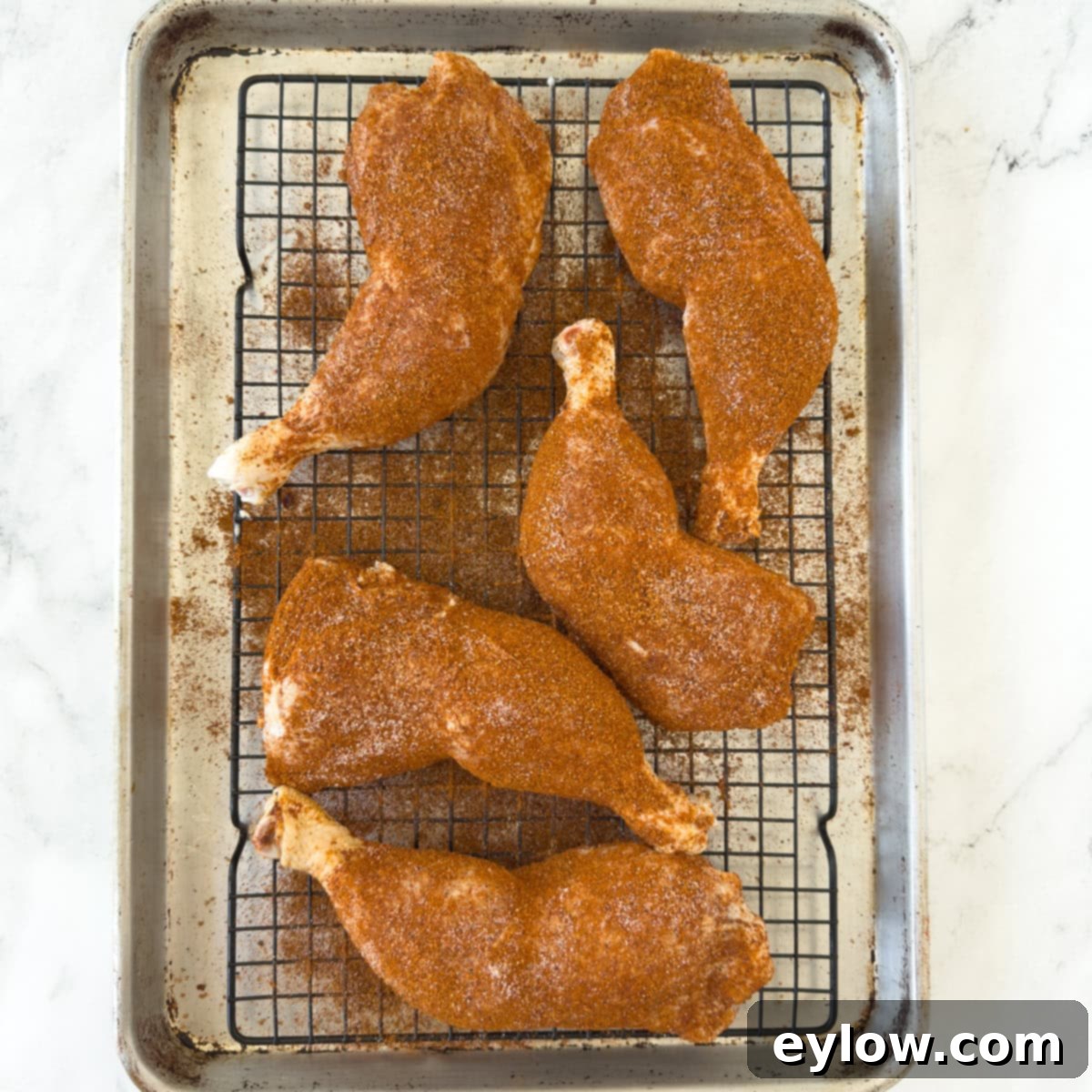
- Bind and Season: Lightly coat all sides of the chicken legs with a thin layer of mayonnaise. This acts as an excellent binder for your dry rub. If your chosen dry rub does not contain salt (many don’t, to allow for personal control), season the chicken lightly with sea salt first. Then, generously apply your dry rub over the entire surface of each chicken leg, ensuring even coverage. Allow the seasoned chicken to rest at room temperature for 45-60 minutes to let the flavors meld and the rub adhere.
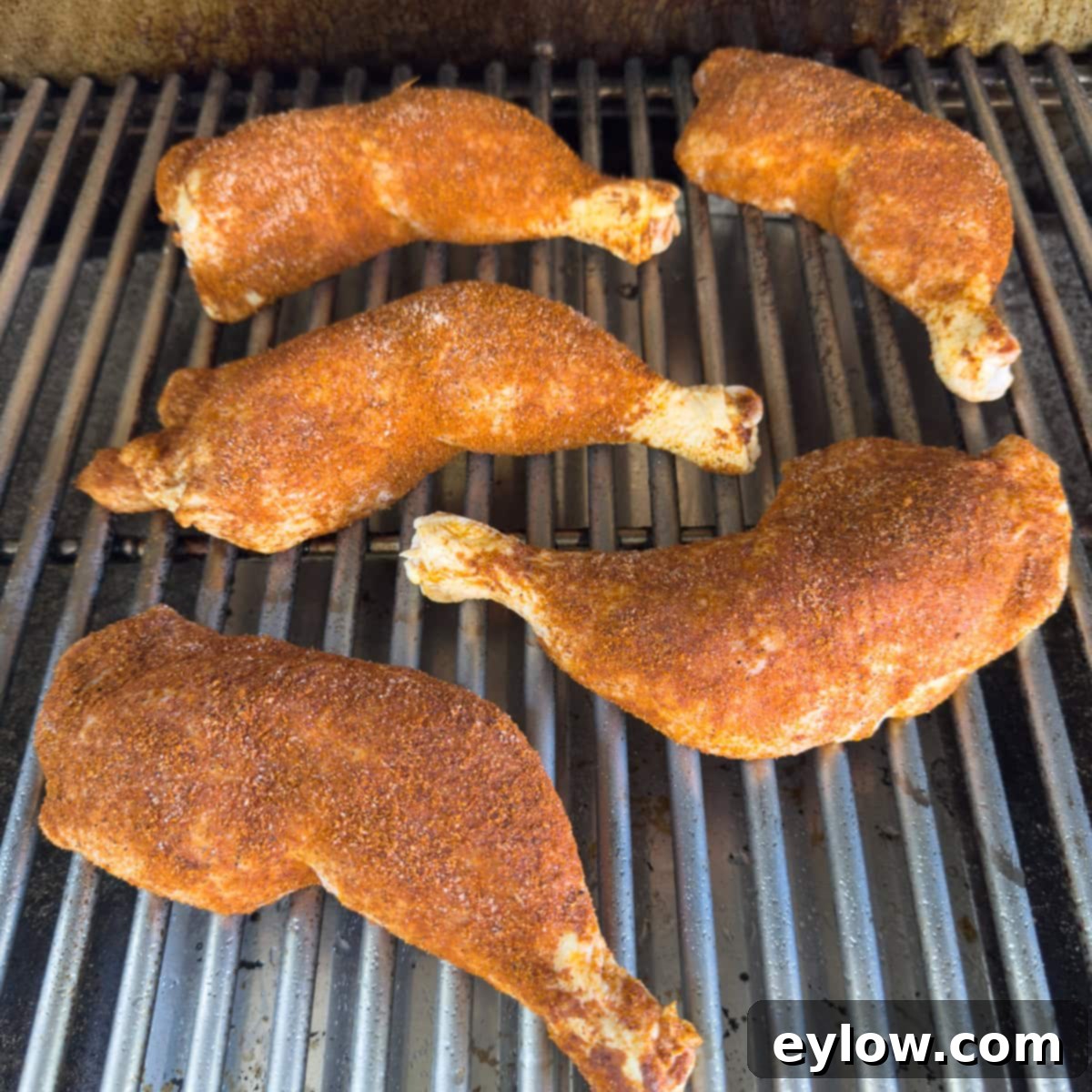
- Smoke the Chicken: Preheat your pellet grill or smoker to your desired temperature, typically 250°F or 275°F. Once preheated and producing clean smoke, place the seasoned chicken legs directly on the clean grill grates, ensuring there is space between each piece for even smoke circulation. Smoke for approximately 1½ to 2 hours, or until the internal temperature of the thickest part of the thigh (avoiding the bone) reaches 175°F. Always use a reliable digital meat thermometer to check for doneness, as cooking times can vary.
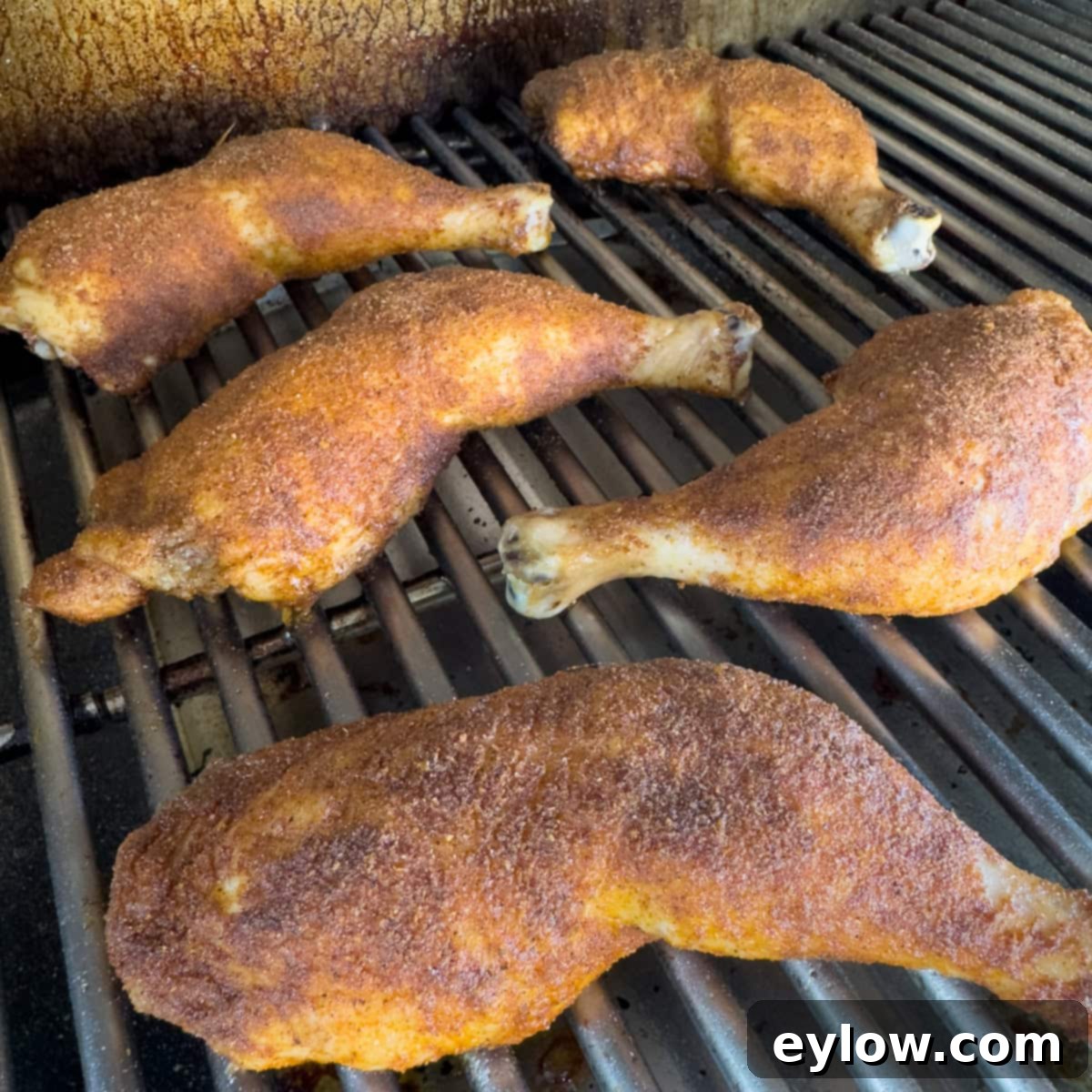
- Glaze and Serve (Optional): Once the chicken legs reach the target internal temperature and look beautifully golden-brown with a developed bark, they are finished and ready to be removed from the grill. If you desire a sweet and tangy finish, brush them with your thinned BBQ sauce using a basting brush during the last 10-15 minutes of smoking, or immediately after pulling them off the heat. Let them rest for 5-10 minutes before serving to allow the juices to redistribute, ensuring maximum tenderness and flavor.
Chef’s Tip: The Unbeatable Advantages of Homemade Rubs and Sauces
Embracing homemade rubs and sauces is one of the simplest yet most impactful ways to significantly elevate your cooking. The primary benefit is complete control over the ingredients: no mysterious fillers, no artificial preservatives, and no excessive sugar. This means you can create flavors that are pure, bold, and precisely tailored to your palate, whether you crave smoky, spicy, herbaceous, or a perfectly balanced blend. Customizing your seasonings allows you to avoid common allergens, reduce sodium intake, and experiment with endless flavor combinations that store-bought options simply can’t match. It’s a small effort that yields tremendous rewards in taste and quality.
Delightful Serving Suggestions for Smoked Chicken Legs
Smoked chicken legs are incredibly versatile and pair beautifully with an array of classic summer side dishes. Whether you’re hosting a lively backyard BBQ, enjoying a casual family dinner, or firing up the smoker for a special occasion, these sides will perfectly complement the rich, smoky flavor of the chicken:
- Homemade Cornbread – This recipe is intentionally made without wheat flour, focusing on bold corn flavor for an authentic taste. It’s naturally gluten-free and becomes even more irresistible when served with a generous swipe of homemade maple butter, adding a touch of sweet richness.
- French Potato Salad – Step away from the ordinary with this fresh and vibrant twist on classic potato salad. Brightened with briny capers, zesty lemon, and a kick of Dijon mustard, it offers a lighter, tangier contrast to the smoky chicken.
- Baked Beans – A true BBQ staple. This from-scratch recipe is deeply satisfying and well worth the time invested, offering layers of savory and sweet flavors. For those in a rush, a clever shortcut option is also provided to achieve similar deliciousness with less effort.
- Broccoli Salad with Bacon – This salad is a symphony of textures and tastes: crunchy broccoli florets, creamy dressing, salty bacon bits, and a hint of sweet raisins or cranberries. It checks every box for a perfect summer side.
- Classic Coleslaw – Simple yet essential. Made with just three main ingredients and tossed in a light, tangy, and refreshing dressing, this coleslaw provides a wonderful crisp counterpoint to the rich chicken.
Any leftover chicken legs should be stored promptly in an airtight container in the refrigerator. When you’re ready to enjoy them, simply shred or chop the meat – it makes for the most amazing, flavorful tacos, versatile sandwich fillings, or a fantastic topping for nachos or loaded fries!
Frequently Asked Questions About Smoked Chicken Legs
At a consistent smoking temperature of 250°F to 275°F, smoked chicken legs will usually take approximately 1½ to 2 hours to fully cook. However, cooking time can vary based on the size of your chicken legs, the specific cut (drumstick vs. leg quarter), and the accuracy of your smoker’s temperature. The most crucial rule for perfectly cooked chicken is always to cook to internal temperature, not just by the clock. For dark meat, aim for an internal temperature of 175°F to 180°F for the best texture and flavor, ensuring the collagen has broken down to achieve maximum tenderness. A reliable digital meat thermometer inserted into the thickest part of the meat (without touching the bone) is your best friend here.
Brining chicken legs is completely optional for this recipe. Dark meat chicken, with its higher fat content and connective tissue, tends to stay naturally moist during the low and slow smoking process, reducing the immediate need for a wet brine. That being said, a dry brine (simply seasoning the chicken liberally with salt a few hours or even overnight before cooking) or applying the full seasoning rub in advance can significantly boost the overall flavor and contribute to even more tender results by allowing the salt and spices to penetrate deeper into the meat. If you have the time, it’s a worthwhile step to enhance your chicken further, but it’s not a make-or-break requirement for a delicious outcome.
For achieving juicy, tender meat infused with a wonderful smoke flavor, a temperature range of 250°F to 275°F is generally considered ideal. This “low and slow” approach allows the smoke to deeply penetrate the meat without drying it out. While you can go slightly higher if you need to accelerate the cooking process, staying within this range provides the best balance of smoke absorption and moisture retention. Remember, unlike chicken breasts which are safely cooked at 165°F, dark meat chicken legs should be cooked to a minimum internal temperature of 175°F to ensure the collagen breaks down sufficiently, resulting in that desirable fall-off-the-bone tenderness.
Absolutely, seasoning chicken legs a few hours in advance or even overnight is a fantastic technique that can significantly enhance both flavor and texture. While not strictly required, pre-seasoning allows the dry rub to fully penetrate the meat, creating a more profound flavor profile. Furthermore, resting the seasoned chicken on a wire rack uncovered in the refrigerator helps to slightly dry the surface of the skin. This process, known as developing a pellicle, is highly beneficial as it improves browning during smoking and can contribute to a more satisfying “bark” and overall appealing appearance. It’s a simple step that offers great rewards if you have the foresight and time.
Explore More Delicious Chicken Recipes
If you’re looking for more culinary inspiration featuring chicken, be sure to check out our comprehensive chicken recipes index page. There, you’ll find a wide variety of dishes to suit every taste and occasion. And specifically, if you’re a fan of chicken thighs and their inherent juiciness, don’t miss these flavorful recipes: try our comforting braised Italian chicken thighs for a rustic meal, or whip up a quick and easy batch of teriyaki chicken thighs for a weeknight favorite.
- Easy Smoked Chicken Breast
- Easy Blender Lemon Chicken Marinade
- How to Make Rotisserie Chicken on a Grill (Step by Step)
- Grilled Hoisin Chicken Skewers
Did You Make This Recipe? We’d Love Your Feedback!
If you’ve had the pleasure of making these smoked chicken legs, we would be absolutely thrilled to hear about your experience! Please take a moment to add your comments below. Your feedback is invaluable to us, and we truly enjoy hearing from fellow home cooks. If you have any questions during the process or about the recipe, don’t hesitate to ask—we’re here to help! And if you truly loved the recipe and found it a delicious addition to your cooking repertoire, we would be incredibly grateful if you could give it a 5-star rating! Your ratings and reviews are tremendously helpful to other readers looking for their next favorite meal.
📖 Recipe

Smoked Chicken Legs
Sally Cameron
Pin Recipe
Equipment
-
Hardwood pellets
-
Pellet grill or smoker
-
Digital thermometer
Ingredients
- 3 ½ pounds whole chicken legs 4 pieces
- 2 tablespoons dry rub
- 1 tablespoon mayonnaise
- sea salt if not in your rub
Instructions
Prep chicken legs
-
Begin by laying your chicken legs top side down on a clean surface. Carefully trim away any noticeable excess fat, as this can render unevenly or drip into your smoker. If the chicken skin feels damp, pat them thoroughly dry with paper towels to ensure optimal rub adherence and bark development. Next, lightly coat each chicken leg with a thin, even layer of mayonnaise. This serves as an excellent binder for the dry rub. If your chosen dry rub does not contain salt, season the legs with a pinch of sea salt, then generously apply the dry rub to both sides of the chicken, ensuring full coverage. Allow the seasoned chicken legs to rest at room temperature for 45-60 minutes before smoking; this helps the rub adhere and enhances flavor penetration.
Prep the smoker
-
While the chicken rests, prepare your smoker. Fill the pellet hopper with your preferred hardwood pellets (see Chef’s Tip for recommendations) and preheat your pellet grill to a stable temperature of 275°F. It’s crucial to allow your smoker to reach and maintain this temperature for at least 15-20 minutes before adding the chicken, ensuring steady heat and clean smoke production. Before placing the chicken, ensure the grill grates are thoroughly clean and lightly oiled or sprayed with cooking spray to prevent any sticking.
Smoke the chicken legs
-
Carefully place the prepared chicken legs directly onto the preheated grill grates. Arrange them in a single layer, leaving a small space between each piece to allow for even smoke circulation. Close the lid and smoke the chicken until the internal temperature reaches between 175°F and 180°F. This typically takes about 1½ to 2 hours, but remember to always cook to temperature, not strictly by time. Use a reliable digital meat thermometer inserted into the thickest part of the thigh, avoiding the bone, to accurately monitor doneness.
When done (optional)
-
Once the chicken legs have reached their optimal internal temperature and boast a beautiful smoky color, remove them from the grill. At this point, you can optionally glaze them with a thinned BBQ sauce using a basting brush or pastry brush. This adds an extra layer of flavor and a lovely sheen.
Note: For a more caramelized glaze, you can apply the BBQ sauce during the final 10-15 minutes of smoking. This allows the sauce to heat up and slightly set on the chicken. After glazing, let the chicken rest for 5-10 minutes before serving to allow the juices to redistribute, ensuring maximum tenderness.
Notes
For those making the homemade dry rub, here are the spices you’ll need:
- 4 ½ tablespoons smoked paprika
- 3 tablespoons granulated garlic powder
- 2 tablespoons brown sugar
- 1 ½ tablespoons cumin
- 1 ½ tablespoons coriander
- 1 tablespoon ancho chile powder
- 1 tablespoon ground black pepper
- 1 teaspoon onion powder
- ¼ – ½ teaspoon chipotle powder or cayenne pepper
